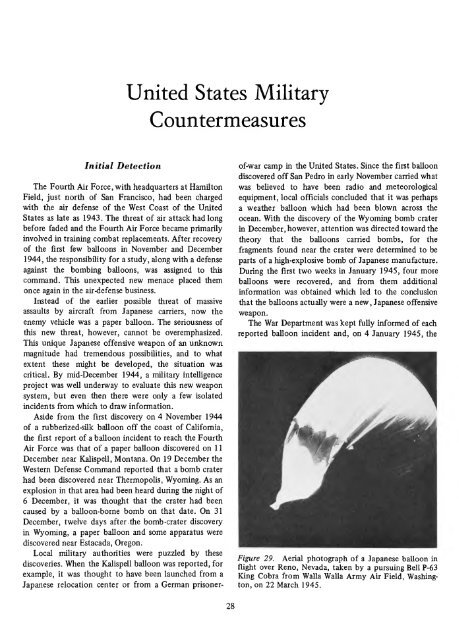Balloon Bomb - Smithsonian Institution Libraries
Balloon Bomb - Smithsonian Institution Libraries
Balloon Bomb - Smithsonian Institution Libraries
Create successful ePaper yourself
Turn your PDF publications into a flip-book with our unique Google optimized e-Paper software.
United States Military<br />
Counter/measures<br />
Initial<br />
Detection<br />
The Fourth Air Force, with headquarters at Hamilton<br />
Field, just north of San Francisco, had been charged<br />
with the air defense of the West Coast of the United<br />
States as late as 1943. The threat of air attack had long<br />
before faded and the Fourth Air Force became primarily<br />
involved in training combat replacements. After recovery<br />
of the first few balloons in November and December<br />
1944, the responsibility for a study, along with a defense<br />
against the bombing balloons, was assigned to this<br />
command. This unexpected new menace placed them<br />
once again in the air-defense business.<br />
Instead of the earlier possible threat of massive<br />
assaults by aircraft from Japanese carriers, now the<br />
enemy vehicle was a paper balloon. The seriousness of<br />
this new threat, however, cannot be overemphasized.<br />
This unique Japanese offensive weapon of an unknown<br />
magnitude had tremendous possibilities, and to what<br />
extent these might be developed, the situation was<br />
critical. By mid-December 1944, a military intelligence<br />
project was well underway to evaluate this new weapon<br />
system, but even then there were only a few isolated<br />
incidents from which to draw information.<br />
Aside from the first discovery on 4 November 1944<br />
of a rubberized-silk balloon off the coast of California,<br />
the first report of a balloon incident to reach the Fourth<br />
Air Force was that of a paper balloon discovered on 11<br />
December near Kalispell, Montana. On 19 December the<br />
Western Defense Command reported that a bomb crater<br />
had been discovered near Thermopolis, Wyoming. As an<br />
explosion in that area had been heard during the night of<br />
6 December, it was thought that the crater had been<br />
caused by a balloon-borne bomb on that date. On 31<br />
December, twelve days after the bomb-crater discovery<br />
in Wyoming, a paper balloon and some apparatus were<br />
discovered near Estacada, Oregon.<br />
Local military authorities were puzzled by these<br />
discoveries. When the Kalispell balloon was reported, for<br />
example, it was thought to have been launched from a<br />
Japanese relocation center or from a German prisonerof-war<br />
camp in the United States. Since the first balloon<br />
discovered off San Pedro in early November carried what<br />
was believed to have been radio and meteorological<br />
equipment, local officials concluded that it was perhaps<br />
a weather balloon which had been blown across the<br />
ocean. With the discovery of the Wyoming bomb crater<br />
in December, however, attention was directed toward the<br />
theory that the balloons carried bombs, for the<br />
fragments found near the crater were determined to be<br />
parts of a high-explosive bomb of Japanese manufacture.<br />
During the first two weeks in January 1945, four more<br />
balloons were recovered, and from them additional<br />
information was obtained which led to the conclusion<br />
that the balloons actually were a new, Japanese offensive<br />
weapon.<br />
The War Department was kept fully informed of each<br />
reported balloon incident and, on 4 January 1945, the<br />
Figure 29. Aerial photograph of a Japanese balloon in<br />
flight over Reno, Nevada, taken by a pursuing Bell P-63<br />
King Cobra from Walla Walla Army Air Field, Washington,<br />
on 22 March 1945.<br />
28
















